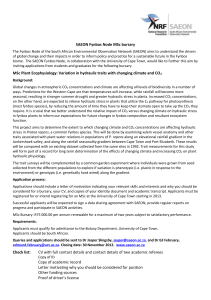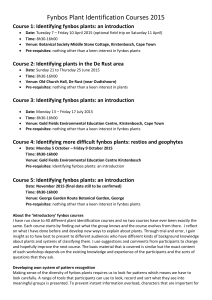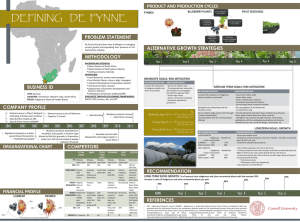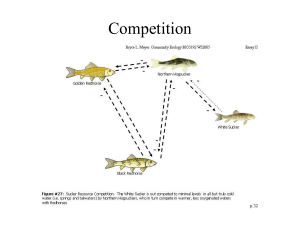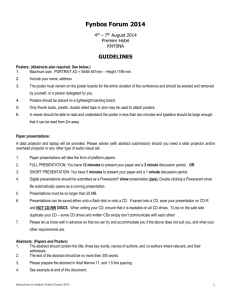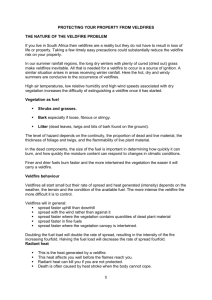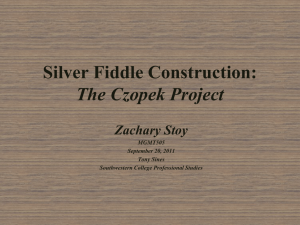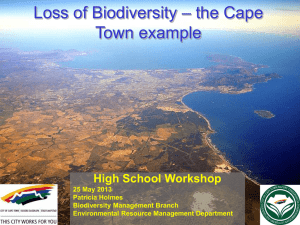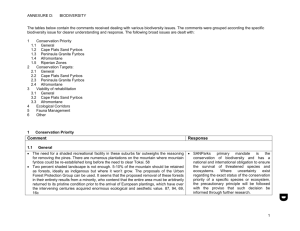PRESENTATION ON RISK CLASSIFICATION OF VELDFIRES AS A
advertisement
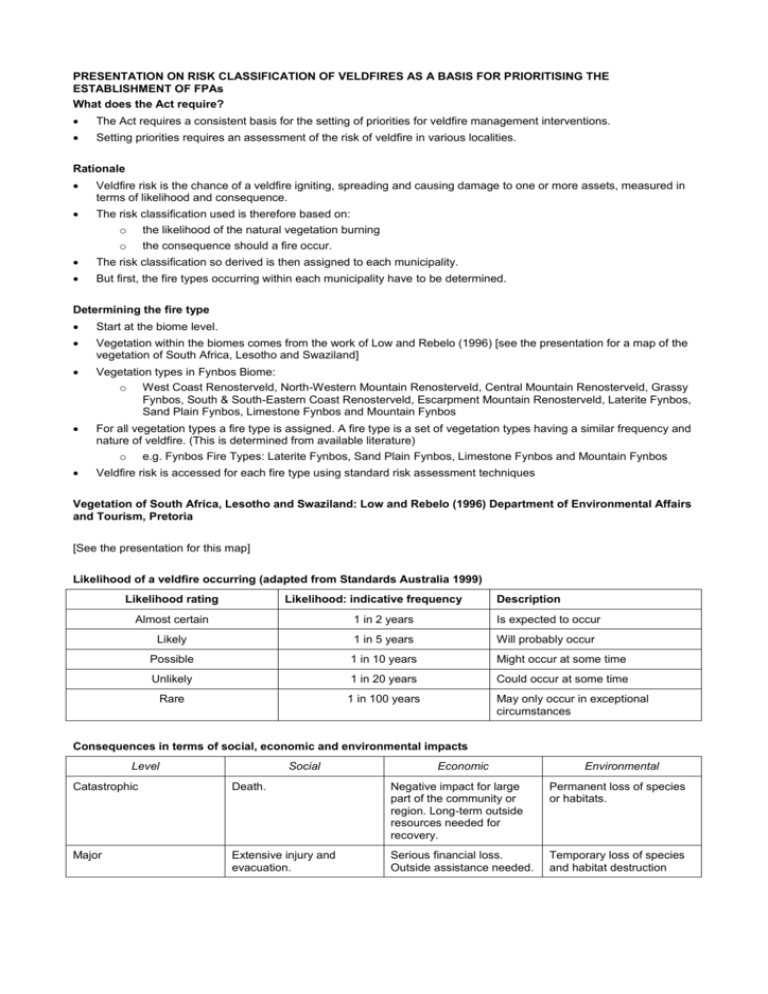
PRESENTATION ON RISK CLASSIFICATION OF VELDFIRES AS A BASIS FOR PRIORITISING THE ESTABLISHMENT OF FPAs What does the Act require? The Act requires a consistent basis for the setting of priorities for veldfire management interventions. Setting priorities requires an assessment of the risk of veldfire in various localities. Rationale Veldfire risk is the chance of a veldfire igniting, spreading and causing damage to one or more assets, measured in terms of likelihood and consequence. The risk classification used is therefore based on: o the likelihood of the natural vegetation burning o the consequence should a fire occur. The risk classification so derived is then assigned to each municipality. But first, the fire types occurring within each municipality have to be determined. Determining the fire type Start at the biome level. Vegetation within the biomes comes from the work of Low and Rebelo (1996) [see the presentation for a map of the vegetation of South Africa, Lesotho and Swaziland] Vegetation types in Fynbos Biome: o West Coast Renosterveld, North-Western Mountain Renosterveld, Central Mountain Renosterveld, Grassy Fynbos, South & South-Eastern Coast Renosterveld, Escarpment Mountain Renosterveld, Laterite Fynbos, Sand Plain Fynbos, Limestone Fynbos and Mountain Fynbos For all vegetation types a fire type is assigned. A fire type is a set of vegetation types having a similar frequency and nature of veldfire. (This is determined from available literature) o e.g. Fynbos Fire Types: Laterite Fynbos, Sand Plain Fynbos, Limestone Fynbos and Mountain Fynbos Veldfire risk is accessed for each fire type using standard risk assessment techniques Vegetation of South Africa, Lesotho and Swaziland: Low and Rebelo (1996) Department of Environmental Affairs and Tourism, Pretoria [See the presentation for this map] Likelihood of a veldfire occurring (adapted from Standards Australia 1999) Likelihood rating Likelihood: indicative frequency Description Almost certain 1 in 2 years Is expected to occur Likely 1 in 5 years Will probably occur Possible 1 in 10 years Might occur at some time Unlikely 1 in 20 years Could occur at some time Rare 1 in 100 years May only occur in exceptional circumstances Consequences in terms of social, economic and environmental impacts Level Social Economic Environmental Catastrophic Death. Negative impact for large part of the community or region. Long-term outside resources needed for recovery. Permanent loss of species or habitats. Major Extensive injury and evacuation. Serious financial loss. Outside assistance needed. Temporary loss of species and habitat destruction needed several years to recover. Moderate Medical treatment needed. Localised damage to property. Short-term external assistance needed. Serious impacts needing a few years to recover. Minor First aid at scene. Slight damage to assets. No external help needed. Environmental assets recover rapidly. Insignificant No injuries. No damage to property. Minor temporary impact Risk levels in terms of likelihood and consequences Likelihood rating Consequence rating Insignificant Minor Moderate Major Catastrophic Extreme (almost certain) Moderate Moderate High Extreme Extreme High (likely) Low Moderate High Extreme Extreme Moderate (possible) Low Moderate High High Extreme Low (unlikely) Low Low Moderate High High Actions to take depending on the level of risk Risk level Action needed Extreme Priority areas for risk reduction measures High Risk reduction measures by all relevant agencies Moderate Routine precautions to be undertaken by landowners Low No action required as veldfire is unlikely and consequences are negligible Risk assessment and assessed risk levels in each fire type in South Africa Fire type Likelihood of critical veldfire scenario Consequence of critical veldfire scenario Veldfire risk level Forest Rare Moderate Low Thicket Rare Moderate Low Arid Woodland Possible Major High Moist Woodland Likely Catastrophic Extreme Sparse Arid Woodland Rare Minor Low Succulent Karoo Rare Minor Low Nama Karoo Unlikely Minor Low Grassy Nama Karoo Possible Minor Medium Coastal Grassland Likely Minor Medium Sour Grassland Almost Certain Catastrophic Extreme Sweet Grassland Likely Moderate High Fynbos Possible Moderate High Renosterveld Unlikely Moderate Risk classification method (at municipal level) Use existing reports to: o o o Assume a critical fire scenario for each fire type. Judge consequences of the scenario. Assess the likelihood of the scenario. Classify risk accordingly. Assign fire risk to each municipality Determine extent of fire type within municipality (Overlay municipality boundaries with Low and Rebelo map which is based on untransformed vegetation) >30% of area with highest fire risk determines fire type for that area The risk level is determined by the dominant fire type Risk level is downgraded if higher risk types are found in areas where they are not a hazard to assets (e.g. Fynbos in isolated mountains) Qualitative explanation of risk classifications Moist woodland and sour grassland both rated as extreme. Fynbos rated as high. Assessed veldfire risk levels in some of the municipalities of the Western Cape, in each fire danger region Fire danger region Municipality code Bokkeveld Name of municipality WC022 Witzenberg WCDMA01 WCDMA01 (Cedarberg) WC025 Major town Critical fire type H Fynbos Citrusdal H Fynbos Breede Valley Worcester M Fynbos (patchy) WC026 Breede River/Winelands Montagu M Renosterveld WC042 Langeberg Riversdale H Fynbos WCDMA03 WCDMA03 (De Hoop Nature Reserve) Bredasdorp H Fynbos WC031 Theewaterskloof Caledon M Renosterveld WC032 Overstrand Hermanus H Fynbos WC033 Cape Agulhas Bredasdorp M Renosterveld WC034 Swellendam Swellendam M Renosterveld Breede River Cape Agulhas to Mossel Bay Cape Hangklip to Cape Agulhas Ceres Veldfire risk level SA municipalities classified by veldfire risk [See the attached documents for this map] Conclusion This veldfire risk assessment provides a basis for prioritising FPAs, and assigning resources accordingly. Those areas with the highest fire risk get the first FPAs. An example at a finer scale This approach can be used at finer scales e.g. Cape Peninsula National Park. However, a comprehensive spatial database of the hazards and the social, environmental and economic assets is needed Veldfire likelihood map (Courtesy of the Cape Peninsula National Park) [See the presentation for this map] Veldfire consequence map (Courtesy of the Cape Peninsula National Park) [See the presentation for this map] Veldfire risk map (Courtesy of the Cape Peninsula National Park) [See the presentation for this map]
